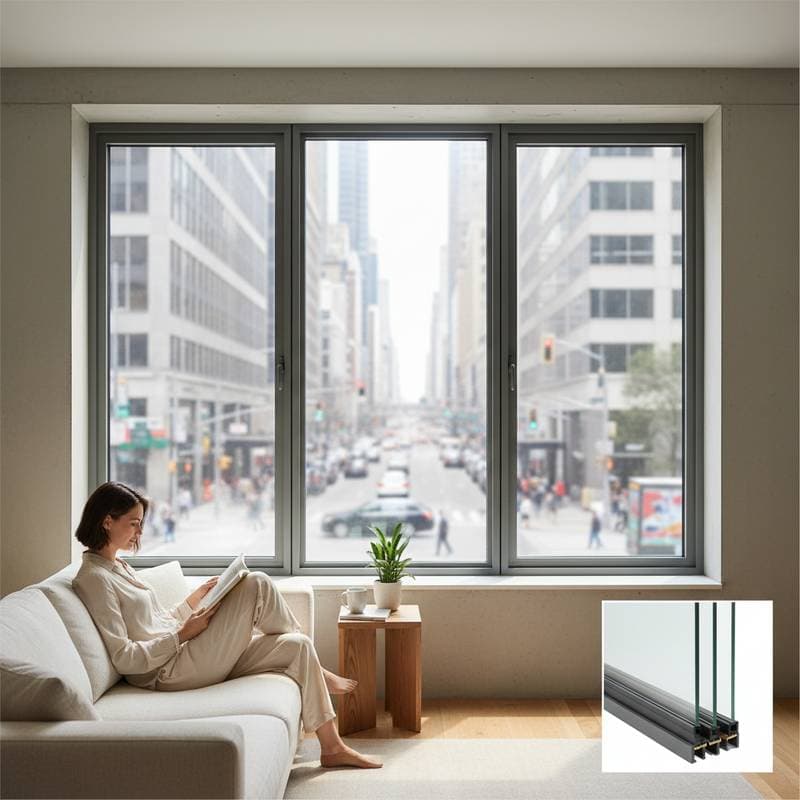Achieving Urban Tranquility: Reduce Noise by 85 Percent with Acoustic Windows
Urban environments offer vibrant energy and accessibility, but they often include persistent sounds from traffic, construction, and daily activity. Acoustic windows provide a proven solution to minimize these disturbances while preserving natural light and visual appeal. These systems employ multiple layers of glazing, airtight seals, and vibration-resistant frames to block up to 85 percent of external noise, fostering interiors that promote relaxation and focus.
This approach aligns with the increasing demand for residential designs that harmonize city dynamism with personal serenity. Property owners prioritize windows that deliver superior sound insulation alongside enduring style, ensuring tranquility enhances rather than isolates from the surroundings.
Budget-Friendly Strategies for Noise Reduction
Entry-Level Option ($3,000 to $6,000)
- Install laminated glass panels within current window frames to target mid-frequency sounds such as voices, vehicle engines, and animal noises.
- Apply acoustic weatherstripping around edges to seal gaps that allow sound transmission.
- Incorporate heavy drapes or cellular shades as an additional barrier for enhanced absorption.
Intermediate Option ($7,000 to $12,000)
- Upgrade to double-glazed units filled with air or argon gas, which improve both sound and thermal insulation.
- Select uPVC or fiberglass frames that dampen vibrations more effectively than metal alternatives and demand minimal maintenance.
- Choose tilt-and-turn hardware for secure closure and controlled airflow without compromising seals.
Premium Option ($13,000 to $25,000)
- Opt for triple-glazed configurations with varied glass thicknesses to neutralize a broad spectrum of frequencies.
- Use composite or thermally broken aluminum frames for structural integrity and reduced heat loss.
- Integrate built-in blinds or low-emissivity coatings to manage daylight and temperature while maximizing sound isolation.
Selecting Materials and Finishes
For windows, prioritize double or triple glazing incorporating laminated layers for optimal performance. Finishes in black, bronze, or woodgrain complement diverse architectural styles, from contemporary to classic. Pair with brushed nickel or matte black hardware to maintain a cohesive, understated appearance.
Coordinate doors using solid-core or acoustically rated models in fiberglass or steel for robust sealing. Include frosted or low-iron glass panels to allow light penetration while upholding privacy standards.
Siding options like fiber cement or engineered wood contribute to overall sound containment through their density. These materials deliver a polished exterior that integrates seamlessly with window installations.
Apply wide trim around openings to visually accentuate windows and eliminate potential sound pathways. Opt for painted surfaces in neutral tones such as slate gray, warm taupe, or soft white to add dimension and harmony.
Essential Maintenance Practices
Acoustic windows endure over time with appropriate care. Clean laminated glass with mild, non-abrasive cleaners to protect the interlayer from scratches and preserve UV resistance.
uPVC and fiberglass frames require only periodic soap-and-water washing, whereas wood variants benefit from regular sealing against moisture. Annual checks on hinges and locks prove vital for heavier triple-glazed setups to prevent operational issues.
Maintain ventilation to avoid pane condensation, ensuring sustained transparency and acoustic efficacy. Diligent routines extend the lifespan of these installations to several decades.
Common Pitfalls to Avoid
Frames warrant equal attention to glass, as subpar construction undermines even advanced glazing. Select frames with integrated seals that match the sound rating of the panes.
Professional installation by certified experts ensures peak performance; consider requesting a sound level verification afterward. Thin profiles may appeal visually but often compromise sealing—favor thicker designs with hidden gaskets.
Address all noise origins beyond streets, including HVAC units, adjacent spaces, and vents, through comprehensive envelope enhancements.
Harmonizing Colors and Styles
Window frame colors influence architectural cohesion. Matte black suits brick or concrete urban facades for sharp, contemporary edges. Soft white or sand tones enhance coastal or suburban settings by promoting light reflection and versatility.
A unified scheme could feature:
- Charcoal black frames
- Warm gray trim
- Pale stone or dove white siding
- Natural oak or walnut doors
- Brushed nickel accents
Such selections infuse warmth and precision, positioning acoustic windows as integral design elements.
Preparing with Photography
Capture your home's exterior before finalizing selections to assess integration. Essential images include:
- Frontal views of all elevations, encompassing upper stories and roof details
- Detailed shots of trim, hardware, and siding surfaces
- Angled perspectives illustrating daily sunlight patterns
- Broader scenes of neighborhood elements, traffic, and landscaping
These references enable precise alignment between new windows and existing features.
Key Planning Considerations
Refine your acoustic project with this framework:
- Compile exterior photos from varied viewpoints for design evaluation.
- Note architectural style—modern, transitional, or traditional—to inform profiles and hues.
- Review local regulations and community guidelines impacting exterior modifications.
- Factor in regional climate for frame stability and moisture management.
- Allocate budget to prioritize high-impact noise control areas.
Integrating for Lasting Impact
Acoustic windows elevate indoor experiences by insulating against urban clamor without severing ties to the environment. Their adaptability suits minimalist modern builds or preserved historic properties alike.
Entry-level modifications like inserts and seals yield notable quietude for modest investments. Mid-tier replacements refresh openings with balanced efficiency. High-end triple glazing ensures enduring silence and sustainability.
Thoughtful decisions in materials, finishes, and upkeep craft spaces that exude sophistication and operate flawlessly, confining external disturbances to the periphery.






